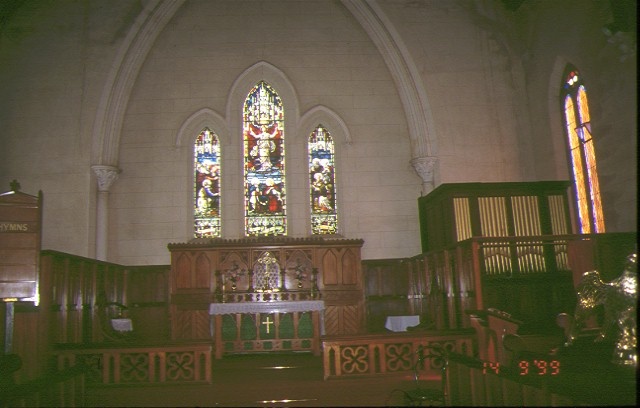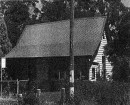HAMLIN PIPE ORGAN
84 BAILEY STREET CLUNES, HEPBURN SHIRE
-
Add to tour
You must log in to do that.
-
Share
-
Shortlist place
You must log in to do that.
- Download report


Statement of Significance
The pipe organ in St Paul's Anglican Church at Clunes was built about 1866 by Hamlin and Son, London, to the order of a Melbourne gentleman for his personal use. The client died before the organ arrived, and the organ remained unused until it was installed in the Methodist Church at Daylesford in 1881. In 1888 the organ was sold to St Paul's Anglican church in Clunes.
How is it significant?
The pipe organ in St Paul's Anglican Church at Clunes is of historic and scientific (technological) significance to the State of Victoria.
Why is it significant?
The pipe organ in St Paul's Anglican Church at Clunes is historically significant as the only known example of the work of the English organ builders Hamlin and Son in Australia.
The organ at St Paul's is scientifically (technologically) significant for its ability to illustrate the development of the organ as a musical instrument, particularly the transition from the English Classical style of organs to the English Romantic design. The organ is also important for its high level of intactness. It retains its unaltered casework and display pipe finishes, and its original console featuring mechanical keys, stop and combination actions, and retractable keyboard. The instrument also exhibits important characteristics in its tonal quality principally as a result of its cone-tuning and original pitch of its pipework (almost half a tone flat by modern standards.
-
-
HAMLIN PIPE ORGAN - History
Contextual History:
The organ has long been a secular instrument, and there are references to organs at the courts of medieval and Renaissance monarchs and in the homes of princess and rich merchants. Such organs were always small. There would normally be only a limited amount of space to house the instrument and the music played on these organs would not be complex - they were for the owners rather than the professional musicians to play.
Many house or chamber organs were built in the eighteenth century and a good many instruments survive in country houses in England. Chamber organs were used for private practice and entertainment. Just as people demonstrated their wealth by building large church or concert-hall organs, so many rich people installed organs in their own homes.
History of Place:
The pipe ogan in St Paul's Anglican Church, Clunes was built about 1866 by Hamlin and Son, London, to the order of a Melbourne gentleman for his own personal use. The young man died before it arrived, and the organ remained unused until it was installed in the Methodist Church Daylesford in 1881. In 1888 the organ was sold to St Paul's where it was erected by William Anderson and opened on the 30 August 1888 by George Herbert.
Hamlin and Son was one of the smaller organ building firms operating in England during the nineteenth century and the organ at Clunes is the only known example of their work in Victoria, indeed Australia. The organ's design illustrates the transition from the English Classical organ to the English Romantic organ. It also appears to have retained its original sound. It is well known for its excellent tone.
The organ at St Paul's Anglican Church Clunes is imporant because the original mechanical actions survive; the console is original and has the seldom-found peculiarity of a retractable keyboard; the pipework retains its cone-tuning and original pitch (almost one half tone flat by present day standards); and the casework and display finishes have remained unaltered.HAMLIN PIPE ORGAN - Assessment Against Criteria
Criterion A
The historical importance, association with or relationship to Victoria's history of the place or object.
N/A
Criterion B
The importance of a place or object in demonstrating rarity or uniqueness.
The organ is important as the only known example of the work of the English organ builders' Hamlin and Son, the only other example of their work surviving in Devon, England. It is also important in including the rare feature of a retractable keyboard.
Criterion C
The place or object's potential to educate, illustrate or provide further scientific investigation in relation to Victoria's cultural heritage.
The organ at St Paul's is significant for its ability to illustrate the development of the organ as a musical instrument, particularly the transition from the English Classical style of organs to the English Romantic design.
Criterion D
The importance of a place or object in exhibiting the principal characteristics or the representative nature of a place or object as part of a class or type of places or objects.
The St Paul's organ exhibits important characteristics in its tonal quality; its retention of original mechanical keys, stop and combination actions; the survival of its original console; the cone-tuning and original pitch of its pipework; and the unaltered casework and display pipe finishes.
Criterion E
The importance of the place or object in exhibiting good design or aesthetic characteristics and/or in exhibiting a richness, diversity or unusual integration of features.
N/A
Criterion F
The importance of the place or object in demonstrating or being associated with scientific or technical innovations or achievements.
N/A
Criterion G
The importance of the place or object in demonstrating social or cultural associations.
N/A
Criterion H
Any other matter which the Council considers relevant to the determination of cultural heritage significance.
N/AHAMLIN PIPE ORGAN - Permit Exemptions
General Exemptions:General exemptions apply to all places and objects included in the Victorian Heritage Register (VHR). General exemptions have been designed to allow everyday activities, maintenance and changes to your property, which don’t harm its cultural heritage significance, to proceed without the need to obtain approvals under the Heritage Act 2017.Places of worship: In some circumstances, you can alter a place of worship to accommodate religious practices without a permit, but you must notify the Executive Director of Heritage Victoria before you start the works or activities at least 20 business days before the works or activities are to commence.Subdivision/consolidation: Permit exemptions exist for some subdivisions and consolidations. If the subdivision or consolidation is in accordance with a planning permit granted under Part 4 of the Planning and Environment Act 1987 and the application for the planning permit was referred to the Executive Director of Heritage Victoria as a determining referral authority, a permit is not required.Specific exemptions may also apply to your registered place or object. If applicable, these are listed below. Specific exemptions are tailored to the conservation and management needs of an individual registered place or object and set out works and activities that are exempt from the requirements of a permit. Specific exemptions prevail if they conflict with general exemptions. Find out more about heritage permit exemptions here.Specific Exemptions:General Conditions:
1. All exempted alterations are to be planned and carried out in a manner which prevents damage to the fabric of the registered place or object.
2. Should it become apparent during further inspection or the carrying out of alterations that original or previously hidden or inaccessible details of the place or object are revealed which relate to the significance of the place or object, then the exemption covering such alteration shall cease and the Executive Director shall be notified as soon as possible.
3. If there is a conservation policy and plan approved by the Executive Director, all works shall be in accordance with it.
4. Nothing in this declaration prevents the Executive Director from amending or rescinding all or any of the permit exemptions.
5. Nothing in this declaration exempts owners or their agents from the responsibility to seek relevant planning or building permits from the responsible authority where applicable.
* minor repairs and maintenace which replace like with like.HAMLIN PIPE ORGAN - Permit Exemption Policy
The importance of the organ lies in its rarity, age and design. No major works should be undertaken without considered, expert professional advice. Day to day repairs and maintenance which allow the instrument to continue to operate should be allowed without a permit.
-
-
-
-
-
CLUNES POST OFFICE
 Victorian Heritage Register H0601
Victorian Heritage Register H0601 -
CLUB HOTEL
 Victorian Heritage Register H0341
Victorian Heritage Register H0341 -
FORMER ES&A BANK (CLUNES)
 Victorian Heritage Register H0340
Victorian Heritage Register H0340
-
'The Pines' Scout Camp
 Hobsons Bay City
Hobsons Bay City -
106 Nicholson Street
 Yarra City
Yarra City -
12 Gore Street
 Yarra City
Yarra City
-
-












